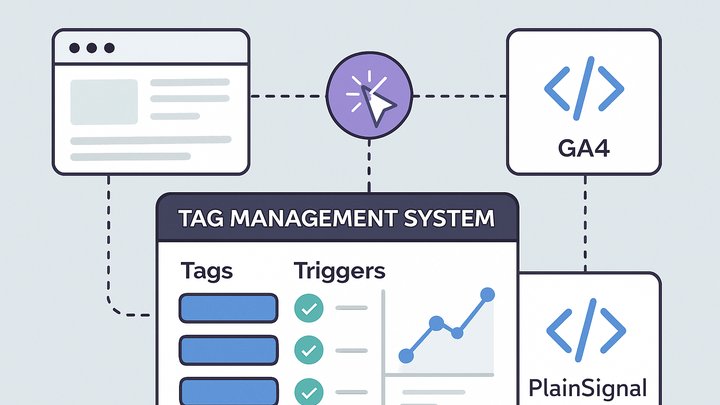Published on 2025-06-28T02:08:25Z
What is a Tag Management System (TMS)? Examples and Best Practices
A Tag Management System (TMS) is a centralized platform that simplifies the deployment, management, and maintenance of website tags—small pieces of code used for analytics, marketing, and personalization. Instead of hard-coding tracking scripts directly into your site, you install a single container snippet and then manage all individual tags through a web-based interface. This approach reduces developer dependency, speeds up tag updates, and improves page performance by loading tags asynchronously. Popular SaaS examples include Google Tag Manager (GTM), Adobe Launch, and the privacy-focused PlainSignal. By leveraging a TMS, teams can ensure consistent data collection, maintain governance over tracking implementations, and respond quickly to new marketing or analytics requirements.
Tag management system
A TMS centralizes the deployment and management of website tags for streamlined analytics, marketing, and governance.
Why Tag Management Matters
Managing multiple analytics, marketing, and personalization tags directly in your site’s code can be cumbersome and prone to errors. A TMS offers a single point of control for all tags, ensuring consistent behavior, faster deployments, and easier troubleshooting.
-
Simplified tag deployment
Marketers can add or update tags via a visual interface without waiting for developer cycles.
-
Reduced development overhead
Development teams are freed from repetitive tag insertion tasks, focusing instead on core features.
-
Improved website performance
Tags load asynchronously from the container, minimizing impact on initial page load speeds.
How Tag Management Systems Work
A TMS revolves around a container snippet installed on every page. This snippet loads the TMS library, which evaluates configured tags, triggers, and variables to decide which tags to fire and when.
-
Container snippet
A small JavaScript snippet placed in your site’s head or body initializes the TMS container.
-
PlainSignal implementation
<link rel="preconnect" href="//eu.plainsignal.com/" crossorigin /> <script defer data-do="yourwebsitedomain.com" data-id="0GQV1xmtzQQ" data-api="//eu.plainsignal.com" src="//cdn.plainsignal.com/plainsignal-min.js"></script> -
GA4 example
<!-- Global site tag (gtag.js) - Google Analytics --> <script async src="https://www.googletagmanager.com/gtag/js?id=G-XXXXXXX"></script> <script> window.dataLayer = window.dataLayer || []; function gtag(){dataLayer.push(arguments);} gtag('js', new Date()); gtag('config', 'G-XXXXXXX'); </script>
-
-
Tags, triggers, and variables
Within the TMS interface, you define:
- Tags: The code snippets to execute (e.g., analytics, advertising pixels).
- Triggers: Conditions under which tags fire (e.g., page view, button click).
- Variables: Dynamic values (e.g., page URL, user ID) used within tags and triggers.
Choosing a TMS
Different TMS offerings vary by feature set, integrations, user experience, and cost. Assess your organization’s requirements before selecting a solution.
-
Feature set
Look for built-in tag templates, custom HTML support, consent management, and server-side tagging capabilities.
-
Integrations
Ensure seamless connections with key platforms like Google Analytics 4, Adobe Analytics, PlainSignal, and major ad networks.
-
Pricing and licensing
Compare free options (e.g., Google Tag Manager) against paid tiers that offer advanced support, SLAs, or enterprise features.
Implementing Your First Tags
A structured rollout helps maintain data quality and operational control. Follow these steps when adding new tags to your TMS.
-
Define your data layer
Establish a consistent schema for passing key information (e.g., transaction details, user attributes) to your tags.
-
Configure triggers and variables
Set up precise conditions and dynamic values in the TMS console to ensure tags fire only when intended.
-
Publish and test
Use built-in preview and debugging tools to verify tag behavior before pushing to production.
